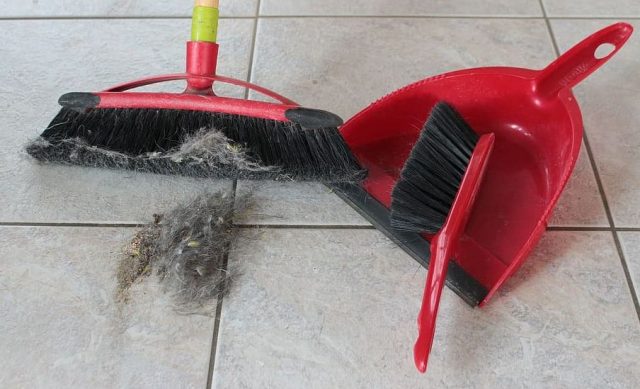You would think a broom would just be a broom. You spill some crumbs or notice some debris on the floor and you grab a broom and clean it up. While any old broom may get the job done, making sure to use the appropriate broom for the job can not only save time, it can save effort and your back too.
Brooms come in various sizes, heights, bristle composition, style, and shape. There are indoor brooms, outdoor brooms, tile brooms, push brooms… you get the idea. If you have many different surfaces in your home or business, you will want to invest in different brooms for the different areas of your space.
Bristle Variations
Bristles of a broom can be comprised of many different types of material. The different materials can be beneficial for the various floor types you may have in your home. Some common materials used for bristles are the following.
- horsehair
- corn husks
- straw blades
- polypropylene
- palmyra
Soft (Straw and Corn) Brooms
Soft brooms are made with bristles that are made out of various materials. The soft broom is noted for the traditional fan shape of its bristles. The soft broom will have bristles typically made from corn husks or straw blades.
Bristles made out of corn husks are popular as the husks are hardy and do not break or bend easily. Sometimes they are too hardy and it may take a while to break the bristles in to become easier to use and more effective in moving debris.
Brooms with bristles made from straw are easier to use at the beginning but will not have the endurance that corn brooms will have. There will typically be several rows of stitching alongside the top of the bristles to hold them together.
Angle Brooms
This broom is a fairly modern broom style. It is popular for the angled bristles that can reach into difficult places such as corners and under cabinets. These brooms I find to be more comfortable to use as the broom is used at an angle in front of you and not straight up and down which can put pressure and strain on your back.
Hard Brooms
For some jobs, you may need to use a stiffer broom. The bristles are harder and stiffer which makes it easier to get into cracks and holes. Hard brooms can poke into these hard-to-reach areas and remove the dirt and debris. A place that is dirty such as a fireplace or hearth would probably be easier and more efficient to clean using a hard broom first before using a softer broom or a vacuum.
Push Brooms
This type of broom is larger and has sturdy bristles to push debris from larger areas. This would be ideal for removing larger pieces of debris from a workplace, basement, or garage area. It may leave behind bits of dirt or smaller debris, but it gets the larger pieces out of the way in a shorter time. The bristles on push brooms are typically made from plastic to be durable for years to come.
Upright Brooms
Upright brooms have bristles that are in a straight line across and directly below the handle. The style and weight are usually similar to the angle broom with bristles cut straight across like the soft broom. This would work better for smaller areas and would get larger debris picked up quickly but may not work well for smaller pieces.
Hand Brooms
Some jobs may require a smaller broom. These brooms are small and the short handle is designed to be used with one hand. A whisk broom or a hand broom would be used for spot cleaning smaller areas such as tabletops or countertops to ensure a clean work surface.
Variations in Handle Materials
Handles can be made from many different types of materials. You will want to choose the handle that best fits the amount and type of use you plan to use that particular broom for.
- Wood – Handles made from wood will be sturdy and comfortable. Make sure to choose a smooth handle to avoid splinters.
- Manufactured Wood – Manufactured wood handles will be sturdy and straight.
- Metal – Metal handles will be very light and strong. As long as the connection to the head is durable, this broom will last many years.
- Plastic – Handles made from plastic are popular for their lightweight and inexpensive cost. The downside is that plastic can become fragile over time especially if stored in a cold environment.
- Bamboo – This fairly new material is very environment-friendly as bamboo grows quickly. It is also very strong and lightweight for ease of use.
- Fiberglass – Handles manufactured from fiberglass are expensive but extremely durable. This is a popular choice for a long-term broom.
Brooms for Specific Jobs
Sometimes you will want a broom specifically to clean a certain area. Here are 10 different types of recommended brooms for tile floors.
Other times you will need a broom best for cleaning concrete floors. Listed here are six types of brooms for sweeping concrete.
Whatever surface you are needing to sweep, by choosing a broom specifically designed for that surface ensures that you are not expending more energy than is needed to do the job.
Review Aids
Some companies will review different products and put them in one place with links to buy the reviewed products. Household Vision is one of these participants that will earn a fee for the advertisement, but the cost of the products is not influenced by the purchases that result from the review. This tool of placing all items in a single area makes it simple and easy to review and compare the items for yourself.
Whether you are cleaning tile, work surfaces, concrete or wood, you need to combine the best bristle composition with the most comfortable and durable handle. This will ensure you work smarter and not harder. And who doesn’t think that is a great idea?

A professional writer with over a decade of incessant writing skills. Her topics of interest and expertise range from health, nutrition and psychology.




